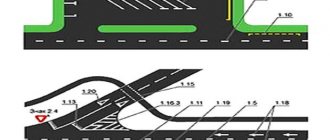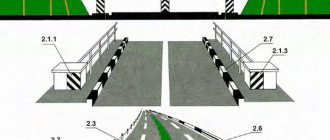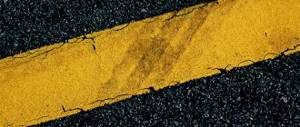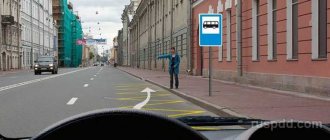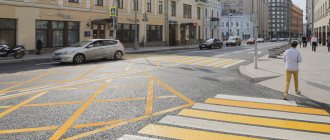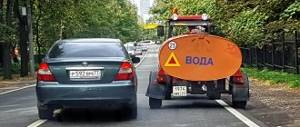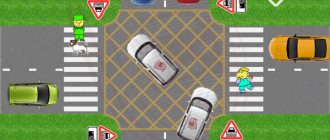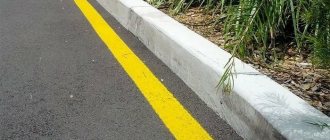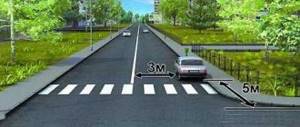What trajectory can you use to make a turn?
| 1. | Only according to A. |
| 2. | Only by A or B. |
| 3. | For any reason. |
In front of you is an unregulated pedestrian crossing marked with a Zebra crossing. The rules prohibit U-turns only at the pedestrian crossings themselves, so you can make a U-turn along path A or B.
Marking according to GOST
The rules and regulations for applying markings are enshrined in GOSTs R 51256-2011 and R 52289-2004. According to them and traffic regulations, there are several types of pedestrian crossings, indicated by numbers:
- 1.14.1 - the most popular option in urban areas, used when the road width is 6 meters;
- 1.14.2 – used when the road width is more than 6 meters and has a flow distribution in the form of arrows.
To designate the area intended for pedestrians, sign 5.19.1 is used, which looks like a blue square with a white triangle inscribed in it and a schematic image of a person.
In addition to the presence of a sign and a traffic light, markings called “zebra” are applied to the asphalt. It looks like white or yellow wide stripes, evenly distributed among themselves. The lanes are always parallel to the roadway.
The width of the zebra crossing directly depends on the intensity of traffic: 1 meter per 500 people per hour. The minimum width is 4 meters. Several years ago, another type of marking took root in Russia - unbroken, alternating white and yellow lines. It is believed that such a designation will lead to a reduction in accident rates on the site.
Marking with paint or plastic
Three types of materials are used for zebra markings:
- Road paint AK-501, 505 or 511. This is the fastest and most inexpensive way. But at the same time, the most short-lived.
- Hot plastic or thermoplastic with the addition of glass beads. In some cases it can be combined with yellow paint. It has increased stability and is used for public roads, highways and overpasses. Apply by mechanized means only.
- Cold plastic. It is used in places where increased wear resistance is required, but thermoplastic is not suitable due to the complexity of the shapes, the small amount of work or the adjacent curb. It can be applied both mechanically and manually.
What should you keep in mind when you see a pedestrian crossing the road ahead?
| 1. | That he can cross the road without changing his pace, or speed up. |
| 2. | That he might suddenly stop or step back. |
| 3. | All of the above should be kept in mind. |
Pedestrians are full participants in road traffic. However, among them there are children, teenagers, elderly people, people with disabilities, people with poor vision or hearing, that is, people who can make mistakes when assessing road situations. Because of such errors, the behavior of pedestrians may be inadequate to the current situation. The pedestrian may run forward, stop, or, having already crossed your lane, step back. All this must be taken into account when approaching pedestrians crossing the road, both at pedestrian crossings and across the roadway.
Modernization
The existing system for organizing pedestrian sections of roads is imperfect. Today, it has been decided to modernize it by introducing certain amendments to the law.
On the official website of the traffic police they proposed to improve the system with reference to the current rules and regulations. Many pedestrian crossings in Russia are not equipped correctly, so they are currently being extensively inspected by state traffic inspectors. A list of comments is also compiled in order to eliminate them.
Pedestrian safety depends on the intensity of traffic flow. And the number of cars increases significantly every year. Therefore, it is necessary to reconsider the systems of zones for pedestrians in each specific locality and throughout the country.
In addition, the occurrence of emergency situations is influenced by the degree of discipline of all road users in the aggregate. First of all, you should start with them - to form the correct view of the procedure for crossing a roadway or pedestrian zone. Having a perfect system will not help if citizens behave undisciplined on the road.
Interesting: The State Traffic Inspectorate suggested holding educational conversations in school institutions to inform children about correct behavior on the roadway.
A proposal has also been put forward to install warning signs, increase the visibility of zebra crossings and take other measures to increase the visibility of pedestrian sections of roads.
Are you allowed to stop at the indicated place?
| 1. | Allowed. |
| 2. | Allowed, but only if there are no pedestrians at the crossing. |
| 3. | Not allowed. |
Answer
- From the place of the intended stop to the edge of the intersecting roadway is exactly 5 m. Stopping in front of the intersection is prohibited if this distance is less than 5 m.
- However, stopping in the indicated place is still prohibited, since the distance between your car and the pedestrian crossing will be less than 5 m.
What is a pedestrian crossing, according to the letter of the law?
Channel PROGRAMMER'S DIARY
The life of a programmer and interesting reviews of everything. Subscribe so you don't miss new videos.
Having barely learned to walk, every child begins to hear about the need to cross the road only at the zebra crossing. This humorous name is a type of black and white marking to designate a specialized area for pedestrians to safely cross to the opposite side of the street or road. This area is a pedestrian crossing.
You may be interested in: Pedestrian zone sign: what does it mean?
For the first time in this form as we know it, PP arose in Europe in the fifties of the twentieth century. And in the Soviet Union, this technique was adopted a little later - in the sixties.
The choice of black and white (or rather gray and white) colors was not made by chance. Scientists have found that this combination of colors is perceived faster than others by the eye. Although today a lot of experiments are being carried out with other combinations, which is reflected in the innovations of GOST 2014.
You may be interested in: Report on the dismissal of a serviceman: sample, requirements and features
According to the standards, pedestrian crossings are installed:
- before intersections;
- close to public transport stops (buses, trams, trolleybuses);
- near schools, hospitals, shopping centers and other heavily visited places.
Depending on the location of the transition, they are of the following types:
- above ground/underground;
- adjustable/unregulated (determined by the presence of a traffic light);
- on the roadway, outside it.
To ensure that such important objects are recognizable to both pedestrians and drivers, the following basic details are used to mark them:
- specialized road markings (aka “zebra”);
- paired pointers.
There are also additional transition symbols:
- signs painted on the asphalt before the start of the zone;
- speed bumps;
- specialized lighting devices along the perimeter of the transition.
Is the driver allowed to reverse in the absence of other road users?
| 1. | Allowed, but only up to the pedestrian crossing. |
| 2. | Forbidden. |
Reversing on roads marked with a one-way road sign is not prohibited. But since there is a pedestrian crossing on the path of travel, where reversing is prohibited, the driver can reverse on this section of the road only up to the pedestrian crossing.
Marking “Pedestrian crossing” in traffic regulations
"Zebra" is known to all motorists without exception. It is designed for safe crossing of the roadway by pedestrians.
Road markings “Pedestrian crossing” are usually presented in the classic form - alternating stripes located at the same distance from each other. However, it also occurs in another type - stripes with guide arrows are located in two rows for the convenience of crossing a large number of people.
The markings are not always used in conjunction with the corresponding sign, and in some cases they are reflective.
Zebra drivers are required to give way to all pedestrians walking along it. At the same time, it is forbidden to “scare” them by accelerating or honking, forcing them to cross the road faster.
You cannot perform certain maneuvers in such a place:
- U-turn. Before the transition or immediately after it, you can, but during it, no.
- Reversing. You can move to it in the opposite direction.
- Overtaking. With such a maneuver, there is a risk that the driver will not notice the pedestrian, which will lead to dire consequences.
- Parking and stopping. You cannot leave your car at the pedestrian crossing itself or 5 meters before it.
The prohibition of these maneuvers was done for a reason. Such measures are necessary to ensure road safety. Therefore, there are large fines for non-compliance with these rules.
Are you allowed to stop at these places?
| 1. | Allowed only in B. |
| 2. | Allowed only in V. |
| 3. | Allowed only in A and B. |
| 4. | Prohibited. |
You can stop at the indicated place (B), since the Rules do not prohibit stopping on the left side of a one-way road (sign 5.5) in populated areas directly behind a pedestrian crossing. Stopping in front of it (places A and B) is prohibited.
Pedestrian crossing sign
So that the driver or pedestrian knows that there is an equipped area for crossing the road nearby (which he is not always able to see from afar), signs 5.19.1 and 5.19.2 are placed on both sides of it. Their design is familiar to everyone: a black man walking “on a zebra crossing” is depicted on a white background.
You may be interested in: How to call a notary to your home: procedure and useful tips
Such signs indicate the territory of the transition (its beginning and end). They must always be present in pairs, even if for some reason there are no markings on the road. It is impossible to have markings without signs. This is not just a gross violation, it is unsafe, since the driver simply will not see the stripes on the road.
Despite the pairing of indicators for PP, in fact, this is the same sign in a mirror image. Such duality is necessary for ease of perception of signs by vehicle drivers. Sign 5.19.1 is always placed to the right of the road, and 5.19.2, respectively, to the left.
According to the requirements of the new standard, in order for the signs to be more visible from afar, they must be outlined along the contour of the figure with yellow-green fluorescent film type B.
Drawing images on the road
One of the activities of the AMK group of companies is painting images on the road. We also apply arrows and numbers on the road. These important marking components indicate the numbering of routes, the direction of movement (including pedestrian traffic), the designation of parking lots for the disabled and other landmarks that allow road users to feel confident on the road.
Our specialists continuously improve their knowledge and experience in the field of road marking. By ordering the application of numbers on the road, images, pedestrian crossing markings from us, you receive high-quality markings, made in accordance with GOST standards, using high-strength materials. And high-quality, easy-to-read markings are the key to a stable road situation and effectively help participants choose a safe way to travel.
You can see other prices for our services on this page.
